We bought our block, out on the Surf Coast of Victoria, Australia, back in 2011. In 2012 we engaged the services of EcoDesigner and Draftsperson, Quin Wyatt, hoping he could help us create an allergy-free, eco-friendly home made from non-toxic, low VOC materials: a safe home capable of protecting my immune system from mould spores; a home designed with passive heating and cooling in mind; a home that’s mindful of climate change and our precious planet.
From 2012 up until this present day, we’ve been testing materials: glues, grouts, paints, silicones, waterproofing materials, wood, cement sheeting, plaster, magnesium board—even tiles. In August 2014 we finished the design. I began the mammoth task of organising quotes and tradespeople; however, after completing this task, we ran into some foreseeable financial hiccups and have had to return to Quin Wyatt asking him to make our house more affordable: we resized our footprint. When we first designed the house, we had another family member to provide for. Now that we are empty nesters, it makes even more sense to downsize. And it will cut costs:
(Before we go any further, here’s our running joke on this situation: my partner, Dan, and I took so long designing, planning and testing materials for this house that we grew older, therefore, as empty nesters, we’ve had to downsize.)
Costs: Just a hardwood house frame—in comparison to the traditionally used terpene-emitting pine frame—costs double that of an ordinary house frame. Include all the double-glazed, thermally-broken windows, and the price has tripled in comparison to ordinary windows. But without these two factors (there are a many others too, but these are the $bangers!), the house won’t be safe for me to live in. Like most chemically sensitive people I desperately need a safe house that won’t impact on my health. My main issues are moulds (outdoor and indoor), solvents, petrochemicals, wood-smoke (PM2.5 particles, particularly). I’ve also had to organize fragrance-free and chemical-free workpeople. It’s been a buzz! And I’ve been diligently taking notes so I can share them all here, at The Labyrinth ~ and finding my way out, with you.
I’ll give you a run-down of the completed plan as soon as I can; otherwise, if I do this now, this post will be my usual 2000 word essay! [For now: think tiles, magnesium board, brick, colourbond, rainwater tanks, balconies and sea air. A vegetable garden set in the front yard—with a duck lurking in amongst the broccoli. Rabbits running free. Two boxers laying out in the sun with me: Freedom: an allergy-free eco-friendly home]
The good news: just like the draftsperson we found, we’ve managed to find some compassionate and understanding tradespeople who’ve agreed to do what absolutely has to happen for this house to ever be a safe, health-tolerable place for me to live.
(When I meditate each morning, gratitude flows from me like the flush of pink petals from a lotus flower in full bloom.)
And, get this: we’ve rented a composting toilet and placed it on our block so the workers (and Dan and I) can use it. No obnoxious chemical fragrance fumes! (More on this in another post. You will love this!)
And luckily, I’ve just experienced a blissful summer and autumn where my health improved enough for me to have actual consecutive days where I was well. (This has not happened since 2011.) Every morning I exercised, then spent the day on the phone organising every detail I could think of; nights were on the computer, compiling notes for my book, the soon-to-be-completed book, Freedom: an allergy-free, eco-friendly home. Thankfully, during this time, most products were already tested for safety—ergo, not all, though (We are stuck at the waterproofing (balcony and bathroom) stage!)
Unluckily, due to moulds and bloody wood-smoke, since winter began—and now the Solstice has passed, which means we’re half way through—I’ve had chronic illness as my companion once again. At least this year, I can deal with it. Some days I even accept it: Yoga, meditation, a supportive partner, energy from a plant-based diet, my latest treatment: the NSP Protocol, my dog, dwarf rabbits, my internet friends, and the faith in building a safe home are getting me through.
At times though, it’s not been easy: hesitation, trepidation, apprehension: a three-headed beast has eaten me alive.
Since I’ve had these well-documented mould symptoms: upper-respiratory inflammation (dry eyes, sinus pain, facial pain, sore throat), fatigue, vagueness, headaches, depression and sadness that mimic actual depression and sadness—all dispelling once the chemical exposure and the mandatory recovery period have passed—not only am I too physically and mentally exhausted to continue in the bull-at-a-gate manner I thrive on, but my confidence, my self-advocacy—swallowed by the inability to follow even my own internal conversations, let alone ones with carpenters/plumbers/manufacturers on the phone—have deserted me. Leaving me alone, plugged into a light socket, buzzing with paralysing fear, emanating through me as I lay in my bed. Unlike the previous times I’ve lost my cognitive abilities (cognitive symptoms started in 2012) I’ve learnt to accept the capabilities of my own brain and memory, especially over the last few weeks; instead of fighting it, I press pause, take the phone off the hook, put a movie on.
It’s okay, this time. I’ve been here before. It, too, shall pass…
I’m lucky, I’m in this build with, and only because of my partner, Dan; and even though, because I’m the chemically sensitive one, I want, need! to be in control of all the materials (for testing and research purposes) and speaking to tradespeople, putting the particulars into writing (for legal reasons), yet, I’ve relinquished this miracle work over to him. He’s actually more assertive than me. If you can imagine that [just add hyper-masculinity and swear words]! I have to trust in his capability. (Of course, I’m still doing the testing; he’s just organising the products and samples for now.)
Here’s how to build a safe home:
Have Faith…
I admire people who believe in God. Any God. The closest thing I have to God is meditation and exercise; and my Dog, which we all know is God spelt backwards. Yoga has been my thing lately. Even my dog has got some type of pose going on:
Enter Ganesha:
This is the brass statue we picked up while searching for this exact statue. We wanted an actual large stone statue for the garden but only found this: still, a statue for the garden. To be buried there, actually.
In the book, 99 Thoughts on Ganesha—Stories, Symbols and Rituals of India’s beloved elephant-headed deity, the author, Devdutt Pattanaik, describes Ganesha as an organic god, one who has transformed throughout time, space history and geography. Pattanaik reminds us:
“Of all the gods in the Hindu pantheon, he alone allows his form to be re-shaped and re-imagined and recreated as devotees will it. Thus, he reminds us constantly that:
Within infinite myths lies the eternal truth Who sees it all?
Varuna has but a thousand eyes Indra, a hundred, You and I, only two”
Pattanaik explains how Ganesha takes the form of the self-created Supreme Being, also known as God, declaring that “whenever social order (dharma) is threatened, he descends to set things right. He offers his devotees three paths to reach him: the path of intellectual introspection (gyan yoga), the path of passionate devotion (bhakti yoga), and the path of detached action (karma yoga).”
During the 7th century CE, after some dudes who just happened to be Tibetan kings married some Buddhist princesses from China and Nepal, Buddhism spread to Tibet. This form is known as Mahayana Buddhism, in which, Ganesha is also known as Vinayaka.
Ganesha of Tibet has two forms: when in the benevolent form, he is the remover of obstacles; in the malevolent form, he is the instigator of obstacles.
Two weeks ago, during a weekend when I was ill, we drove the five minutes it takes to get to our block and held a ceremony: we buried a brass statue of Ganesha, asking for his help to remove any obstacles that may be placed in our way.
I feel better now…
Do you have any beliefs, rituals or deities that get you through the tough times? If so, please share…
Oh, and if you know of a low VOC, waterproofer for balconies (that are to be tiled) and for placing under tiles in the bathroom, please let us know. It has to be inert once dry (it’s the chemicals that outgass, not the actual smell, that’s the problem.) and it must be non-toxic to someone sensitive to chemicals, please.

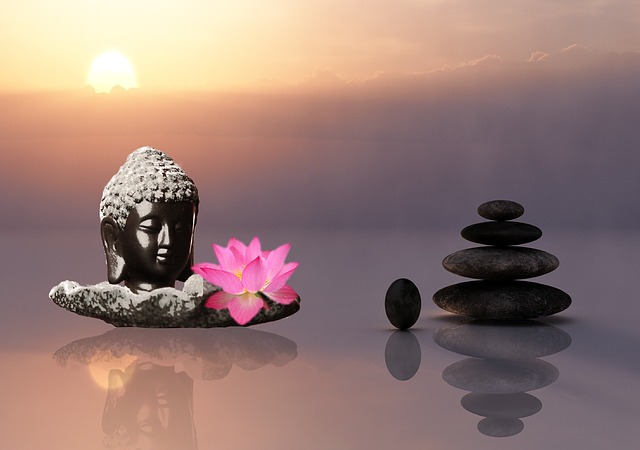


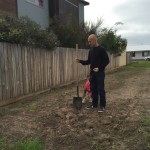
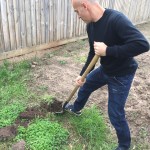
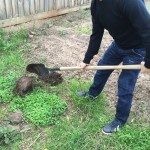


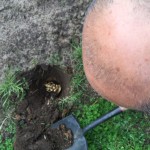
We are hoping to build soon, too! Yes, I do believe in the God of the Bible, the God of Abraham, Isaac, Jacob, and Father of Jesus. Some of the most comforting words, for the tough times, that I have found in the Bible are these: “‘Let not your heart be troubled; you believe in God, believe also in Me. In My Father’s house are many mansions; if it were not so, I would have told you.” Looking forward to those mansions, especially after struggling with homelessness!!!! About bathroom tiles–we are going to use a cast-iron tub, not a shower going on tiles. Do you know if we still need waterproofing between cement slab and bathroom floor tiles? Also, I have heard that ceramic tiles will “block” most chemicals from coming up from underneath, but I don’t know if that is true. We, too, have had trouble finding waterproofing things. Thanks, and looking forward to hearing more!!
Ooh, lovely, I’d love to hear more about your build. I think it’s important for us to share on the information we can. That way we can be of assistance to others. It’s not easy living a life while sensitive to chemicals, and, as I’ve found, very difficult to try and create a safe home from scratch… Those are lovely words you shared above; thank you. I, too, look forward to the ‘mansions’. I’m not sure if you need the waterproofing between the tiles and slab. If the slab is sealed, as concrete is porous, it may be okay. Although, you just don’t want to get any water in gaps where it can’t get dried. Mould is horrid for people like us. I’d like to know if ceramic tiles can actually do that. I’ve been looking at ceramic and porcelain tiles. (Glazed.) Ardex make a low VOC waterproofer. I have some on a piece of tile airing outside. I’ll do a post about it when it’s ready to test out.
We are using the book Healthy House Building for the New Millennium (John Bower). It’s a super book! The main differences are that nowadays they make sheep’s wool insulation (which we are going to use), and we are putting in in-floor heating under the slab. (Cold climate, etc.) We aren’t sealing the cement slab (Bower doesn’t say anything about that, but he DOES say a lot of insulation under the slab, as well as plastic so water can’t wick up, which we are doing). Yes, I do horrible with any kind of mould. I have some ceramic tiles in the shed where I am sleeping right now (actually just sitting there, not adhered to the floor). They definitely block chemicals, because I had been using a new mattress, which literally got chemicals (flame retardants) all over the shed. Wiped down the (metal) shed, which worked, but still was in the cement floor. So, we put glazed ceramic tiles on the floor, and immediately that made a difference. I stopped getting sick to my stomach and slept better than in a long time. But I will look under them and see what the moisture situation is. We did put plastic under the shed slab, but no insulation (because we knew I wouldn’t be able to sleep in there in the winter anyway). In the house, we hope to have very thin grout between tiles. But I am still thinking that sealing the grout in the bathroom and probably kitchen might be a good idea. I think more can get through the grout than the tiles?? I recently read about water glass (sodium silicate), and I think I would do well with that because it is not really a chemical. Someone also mentioned beeswax for water proofing, but that would probably be more for wood things (like my outdoor bench :)). Looking forward to hearing about the Ardex!
So I put a little puddle of water on one of my glazed ceramic tiles in the shed, and later–no water under tile! Since the tile is not cemented down in the shed, I could lift it up and look. The little puddle just evaporated from the top. So I’m guessing any water problem would have to come from below the slab (wicking up) or between tiles (in grout). (I didn’t get any water between the tiles like one might splashing from a sink, etc.). When I looked under the tile, I did see a little water stain from where rain had blown in the shed onto the concrete before adding tiles, but I don’t think it was damp at all. (But we do live in a very dry climate. Especially this time of year.) I’m thinking now about possibly putting some tiles in the shed the right way (grout and all) and splashing water over, and then maybe prying up tile, to see what’s under…. If I can convince hubby it’s worth breaking a few tiles…. LOL
The little puddle just evaporated from the top. So I’m guessing any water problem would have to come from below the slab (wicking up) or between tiles (in grout). (I didn’t get any water between the tiles like one might splashing from a sink, etc.). When I looked under the tile, I did see a little water stain from where rain had blown in the shed onto the concrete before adding tiles, but I don’t think it was damp at all. (But we do live in a very dry climate. Especially this time of year.) I’m thinking now about possibly putting some tiles in the shed the right way (grout and all) and splashing water over, and then maybe prying up tile, to see what’s under…. If I can convince hubby it’s worth breaking a few tiles…. LOL
Hi Christa, I hope the water didn’t come up from the slab, is it newly laid? Yes, that’s a good idea to waste a few tiles and see what happens. Make sure you give your slab time to dry before doing that. We don’t want you exposed to any mold. Stay well
No water has come up from the slab–yay! Yes, newly laid. (Plastic underneath for vapor barrier.) It’s just that how the shed was attached to the slab leaves places for rain to blow in from the side, so to speak. Maybe by next rainy season, we can apply more caulk at the bottom?? Yes, good point to make sure it’s dry. Concrete is so weird–it seems to keep the water stain, but it must dry since I’m not getting any mold symptoms. I’ll probably take a hair dryer to it before tiling, just in case. Haven’t gotten to the point of trying tile experiments yet. Life/other house stuff has been so busy! The latest is that we were trying to get some kind of fridge to offgas the plastic inside before having to use it, BUT we found a fridge with all stainless steel outside AND inside–yay!!!! Ugly as all get out, but will be so much better. How is your build coming? You stay well, too!!
but will be so much better. How is your build coming? You stay well, too!! 
Hey! My build is coming along slowly but safely. We have found a waterproofer sealant made by Laticrete. So far, most of Laticrete’s products are non-chemically stinky—for me anyway. Your stainless steal fridge sounds just awesome. You are so lucky! My last fridge had to live outside, which meant to get food we had to go outside to get it. Our latest fridge is all good though. Yes, concrete takes an awful long time to dry!
My last fridge had to live outside, which meant to get food we had to go outside to get it. Our latest fridge is all good though. Yes, concrete takes an awful long time to dry! 
Ooo–I’ll have to look up Laticrete!
Good luck on your house.
Thank you, we need it.